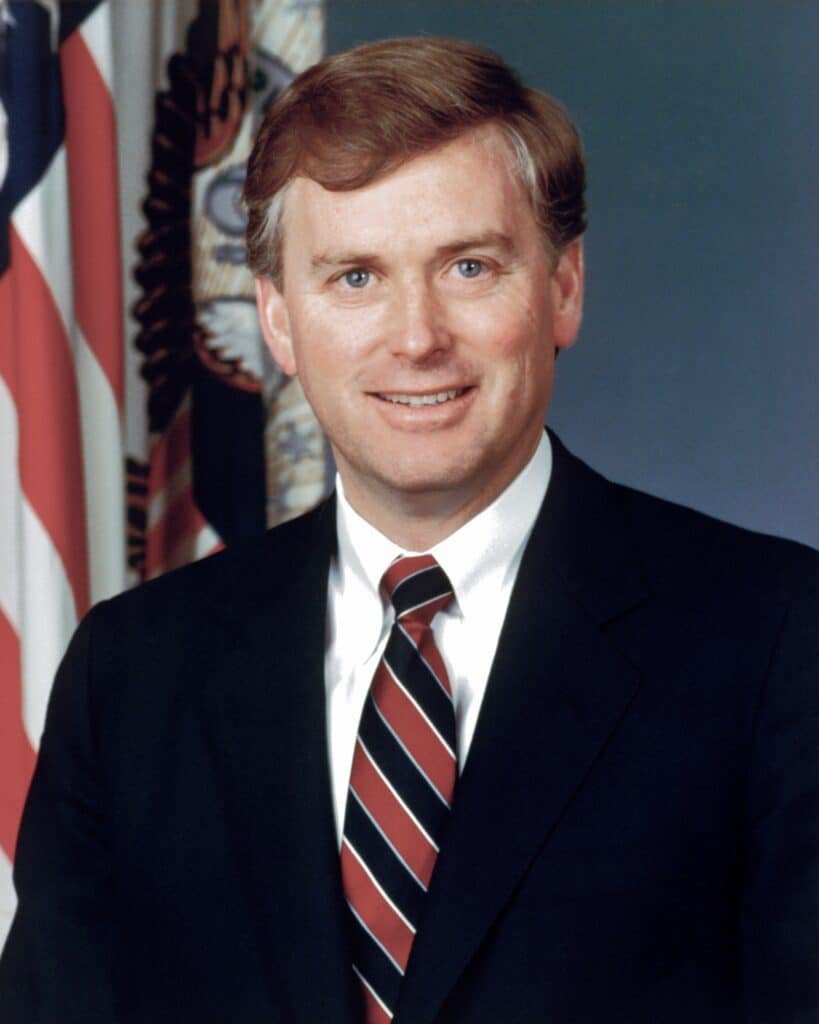




Dan Quayle
James Danforth “Dan” Quayle (1947– still alive) served as the 44th Vice President of the United States under President George H.W. Bush from 1989 to 1993. Known for his youthfulness, conservative views, and public gaffes, Quayle became one of the most controversial and scrutinized vice presidents in modern American history. Despite the challenges of his tenure, Quayle played a significant role in the administration’s domestic and foreign policies during the waning years of the Cold War and the Gulf War.
Early Life and Education
Dan Quayle was born on February 4, 1947, in Indianapolis, Indiana, to James C. Quayle and Martha Corinne Pulliam. His father was a prominent newspaper publisher, and his mother was part of the Pulliam family, owners of the Indianapolis Star and The Arizona Republic. Growing up in a family with deep ties to journalism and business, Quayle was exposed to leadership and public service from an early age (Duffy & Goodgame, 1992).
Quayle spent much of his childhood in Huntington, Indiana, where he attended public schools. He later enrolled at DePauw University in Greencastle, Indiana, graduating in 1969 with a degree in political science. During his college years, Quayle was a member of the Delta Kappa Epsilon fraternity and displayed an interest in public affairs and politics (Schneider, 1994).
After completing his undergraduate studies, Quayle joined the Indiana National Guard in 1969, serving during the Vietnam War. His service in the Guard shielded him from deployment overseas, a decision that later drew criticism during his political career. In 1974, Quayle earned his law degree from the Indiana University Robert H. McKinney School of Law, setting the stage for his entry into politics (Duffy & Goodgame, 1992).
Entry into Politics
Quayle’s political career began in 1976 when he successfully ran for the U.S. House of Representatives, representing Indiana’s 4th Congressional District. At 29 years old, he was one of the youngest members of Congress. During his two terms in the House (1977–1981), Quayle focused on issues such as economic growth, national security, and education reform. His legislative record reflected his conservative ideology and commitment to traditional values (Pomper, 1993).
In 1980, Quayle ran for the U.S. Senate, defeating three-term incumbent Democrat Birch Bayh in a surprising victory. Quayle’s campaign emphasized limited government, fiscal conservatism, and a strong national defense, themes that resonated with voters during the Reagan era. As a senator, Quayle continued to champion conservative causes, including tax reform, military spending, and anti-abortion policies. He also gained recognition for his work on the Armed Services Committee and the Labor and Human Resources Committee (Schneider, 1994).
Vice Presidency
In 1988, Vice President George H.W. Bush selected Quayle as his running mate in the presidential election. The choice of Quayle surprised many political observers, as he was relatively unknown on the national stage. Bush’s decision was seen as an attempt to appeal to younger voters and solidify support among conservatives. The Bush-Quayle ticket won a decisive victory over Democratic candidates Michael Dukakis and Lloyd Bentsen, and Quayle was inaugurated as Vice President on January 20, 1989 (Pomper, 1993).
Role and Responsibilities
As Vice President, Quayle took on several key responsibilities, including chairing the Council on Competitiveness, which focused on reducing regulatory burdens on businesses and promoting economic growth. He also served as chairman of the National Space Council, where he advocated for increased funding for space exploration and the development of commercial space initiatives. Quayle’s efforts in these roles reflected his commitment to economic innovation and technological advancement (Duffy & Goodgame, 1992).
Quayle was a vocal supporter of the administration’s foreign policy, particularly during the Gulf War. He traveled extensively to represent the United States, meeting with foreign leaders and promoting American interests abroad. Despite these contributions, Quayle’s public image was overshadowed by frequent media scrutiny and criticism of his perceived inexperience and verbal missteps (Schneider, 1994).
Public Perception and Controversies
Quayle’s vice presidency was marked by intense media attention and public ridicule. His verbal gaffes, such as misspelling “potato” during a school visit and his remarks about single motherhood and family values, became defining moments of his tenure. Critics often portrayed him as intellectually unprepared for the vice presidency, while supporters argued that the media exaggerated his mistakes and unfairly targeted him (Pomper, 1993).
One of Quayle’s most controversial moments came in 1992, when he criticized the television show Murphy Brown for promoting single motherhood. His comments sparked a national debate about family values and cultural norms, highlighting the ideological divide between conservatives and liberals. Although Quayle defended his stance as a critique of declining moral standards, the incident further cemented his reputation as a polarizing figure (Duffy & Goodgame, 1992).
1992 Election and Post-Vice Presidency
The Bush-Quayle administration faced significant challenges in the 1992 election, including an economic recession, internal divisions within the Republican Party, and the rise of independent candidate Ross Perot. The Democratic ticket of Bill Clinton and Al Gore defeated Bush and Quayle in a decisive victory, ending their tenure in the White House (Schneider, 1994).
After leaving office, Quayle returned to Indiana and focused on writing, public speaking, and business ventures. He published his memoir, Standing Firm, in 1994, which offered a defense of his vice presidency and reflections on his political career. The book became a bestseller and provided insight into Quayle’s perspective on the challenges he faced in office (Quayle, 1994).
Quayle briefly reentered politics in 1999 when he announced his candidacy for the Republican presidential nomination in the 2000 election. However, his campaign failed to gain traction, and he withdrew before the primaries. Despite this setback, Quayle remained active in public life, serving as chairman of the private equity firm Cerberus Capital Management and continuing to advocate for conservative principles (Pomper, 1993).
Personal Life and Character
Dan Quayle married Marilyn Tucker in 1972, and the couple had three children: Tucker, Benjamin, and Corinne. Marilyn Quayle, an attorney and author, played an active role in her husband’s political career, often serving as a surrogate on the campaign trail and promoting family-oriented policies. The Quayles have been described as a close-knit family, deeply committed to their faith and traditional values (Duffy & Goodgame, 1992).
Quayle’s character was often defined by his resilience in the face of criticism and his commitment to public service. While his public image was shaped by controversies and media portrayals, those who worked closely with him emphasized his work ethic, loyalty, and dedication to his responsibilities. Quayle’s ability to navigate the challenges of national politics and maintain a focus on his priorities speaks to his perseverance and determination (Schneider, 1994).
Final Summary
Dan Quayle’s life and career reflect the complexities of American politics and the challenges of leadership in the modern media age. From his early days as a congressman and senator to his tenure as Vice President, Quayle consistently championed conservative values and sought to address the issues of his time. While his vice presidency was marked by controversy and public scrutiny, his contributions to economic innovation, space exploration, and foreign policy underscore his dedication to public service.
References
Duffy, M., & Goodgame, D. (1992). The Dan Quayle Story: From Lawmaker to Laughingstock. New York: Birch Lane Press.
Pomper, G. M. (1993). The Election of 1992: Reports and Interpretations. Chatham, NJ: Chatham House Publishers.
Quayle, D. (1994). Standing Firm: A Vice-Presidential Memoir. New York: HarperCollins.
Schneider, W. (1994). The Vice Presidency in Modern America. Boston: Beacon Press.
Unger, I. (1993). The Times of Our Lives: America During the Bush Administration. New York: HarperCollins.